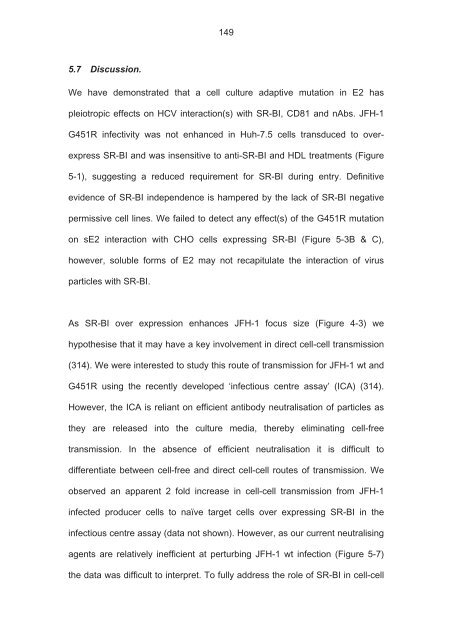The role of scavenger receptor BI in hepatitis - eTheses Repository ...
The role of scavenger receptor BI in hepatitis - eTheses Repository ...
The role of scavenger receptor BI in hepatitis - eTheses Repository ...
You also want an ePaper? Increase the reach of your titles
YUMPU automatically turns print PDFs into web optimized ePapers that Google loves.
5.7 Discussion.<br />
149<br />
We have demonstrated that a cell culture adaptive mutation <strong>in</strong> E2 has<br />
pleiotropic effects on HCV <strong>in</strong>teraction(s) with SR-<strong>BI</strong>, CD81 and nAbs. JFH-1<br />
G451R <strong>in</strong>fectivity was not enhanced <strong>in</strong> Huh-7.5 cells transduced to over-<br />
express SR-<strong>BI</strong> and was <strong>in</strong>sensitive to anti-SR-<strong>BI</strong> and HDL treatments (Figure<br />
5-1), suggest<strong>in</strong>g a reduced requirement for SR-<strong>BI</strong> dur<strong>in</strong>g entry. Def<strong>in</strong>itive<br />
evidence <strong>of</strong> SR-<strong>BI</strong> <strong>in</strong>dependence is hampered by the lack <strong>of</strong> SR-<strong>BI</strong> negative<br />
permissive cell l<strong>in</strong>es. We failed to detect any effect(s) <strong>of</strong> the G451R mutation<br />
on sE2 <strong>in</strong>teraction with CHO cells express<strong>in</strong>g SR-<strong>BI</strong> (Figure 5-3B & C),<br />
however, soluble forms <strong>of</strong> E2 may not recapitulate the <strong>in</strong>teraction <strong>of</strong> virus<br />
particles with SR-<strong>BI</strong>.<br />
As SR-<strong>BI</strong> over expression enhances JFH-1 focus size (Figure 4-3) we<br />
hypothesise that it may have a key <strong>in</strong>volvement <strong>in</strong> direct cell-cell transmission<br />
(314). We were <strong>in</strong>terested to study this route <strong>of</strong> transmission for JFH-1 wt and<br />
G451R us<strong>in</strong>g the recently developed ‘<strong>in</strong>fectious centre assay’ (ICA) (314).<br />
However, the ICA is reliant on efficient antibody neutralisation <strong>of</strong> particles as<br />
they are released <strong>in</strong>to the culture media, thereby elim<strong>in</strong>at<strong>in</strong>g cell-free<br />
transmission. In the absence <strong>of</strong> efficient neutralisation it is difficult to<br />
differentiate between cell-free and direct cell-cell routes <strong>of</strong> transmission. We<br />
observed an apparent 2 fold <strong>in</strong>crease <strong>in</strong> cell-cell transmission from JFH-1<br />
<strong>in</strong>fected producer cells to naïve target cells over express<strong>in</strong>g SR-<strong>BI</strong> <strong>in</strong> the<br />
<strong>in</strong>fectious centre assay (data not shown). However, as our current neutralis<strong>in</strong>g<br />
agents are relatively <strong>in</strong>efficient at perturb<strong>in</strong>g JFH-1 wt <strong>in</strong>fection (Figure 5-7)<br />
the data was difficult to <strong>in</strong>terpret. To fully address the <strong>role</strong> <strong>of</strong> SR-<strong>BI</strong> <strong>in</strong> cell-cell

















